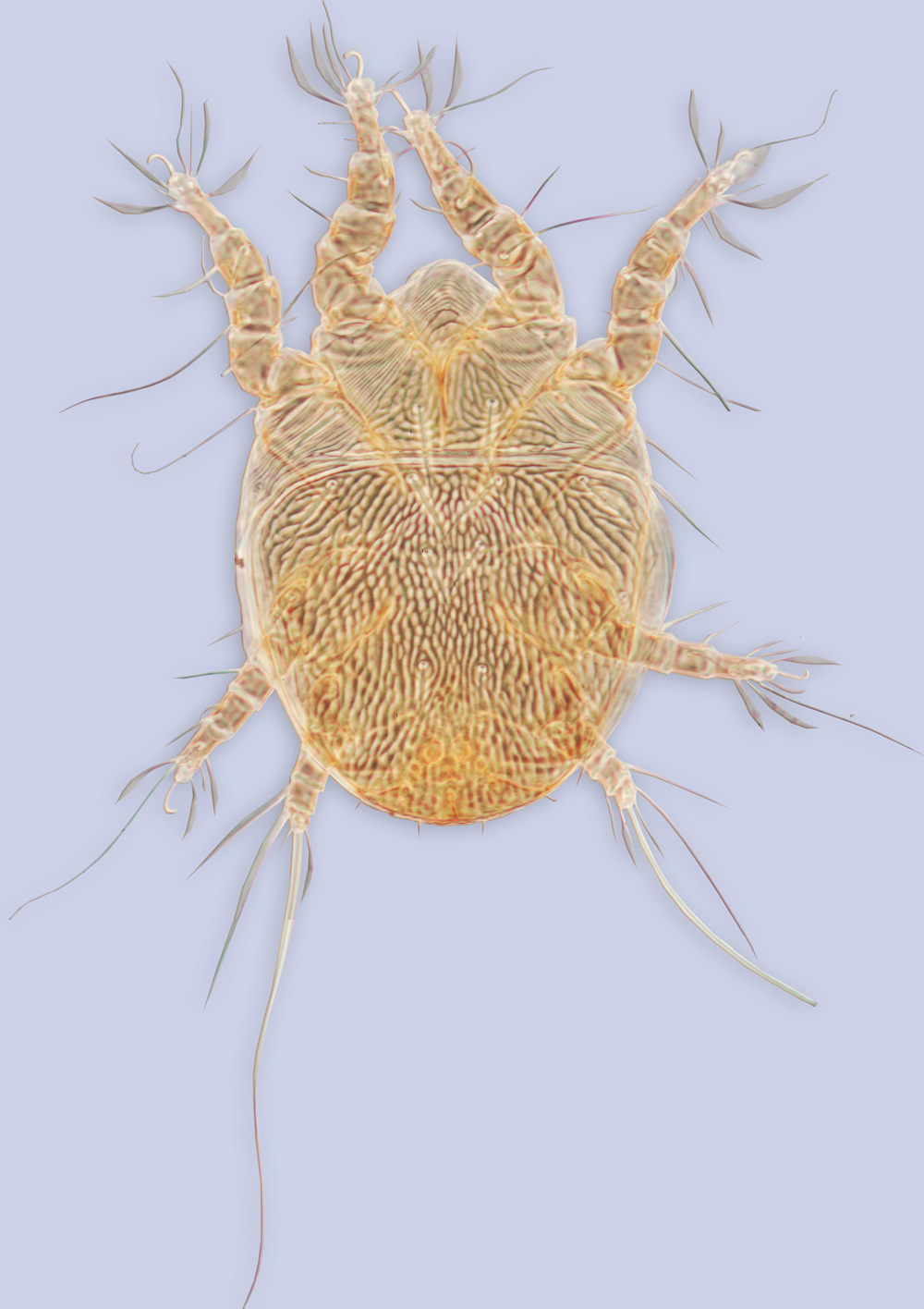Bee Mites :
Acari :
Acariformes :
Sarcoptiformes :
Chaetodactylidae
Genus Centriacarus Klimov and OConnor, 2007
Centriacarus Klimov & OConnor, 2007a: 814; Klimov et al., 2007b: 1370; Klimov & OConnor, 2008: 99.
Type species Centriacarus turbator Klimov and OConnor, 2007, by original designation
Description (unique character states underlined). Phoretic deutonymph. Gnathosomal solenidion, free palpi and their setae present. Alveoli ve dorsal, distinctly anterior to se. Prodorsal shield striation longitudinal anteriorly and transverse posteriorly. Prodorsal shield present. Posterior edge of prodorsal shield shorter than its lateral edges. Setae se situated on soft cuticle. Setae c2 situated on same transverse level as c1. Setae e2 situated on hysterosomal shield. Setae 1a and 3a touching posterior borders of respective coxal fields and filiform. Cupules ia situated on hysterosomal shield. Cupules im distinctly posterior to acetabula III, situated off line between d2 and e2. Cupules ip anterior to setae f2. Cupules ih situated on sides of attachment organ. Posterior part of posterior apodemes of coxal fields II not displaced posteriorly to anterior apodemes III. Coxal fields III closed. Coxal fields IV open. Transverse medial extension of posterior apodemes IV well-developed. Anterior extension of posterior apodemes IV present, connecting with anterior apodeme III. Ventral longitudinal sclerites of progenital chamber conspicuous at posterior part. Ventral longitudinal sclerites of progenital chamber conspicuous at anterior part. Posterior and lateral cuticular suckers (Fig. 2) present. Anterior cuticular suckers present (Fig. 2). Bases of anterior cuticular suckers inserted on separate apodeme (may touch or overlap posterio-lateral sclerotized border of the attachment organ) (Fig. 2). Apodemes of ps1 separated. Setae wa I-II submedial, f I-II apical, near tarsal apices. Solenidion ω2 present. Empodial claws I-III not twisted. Dorsal cuticular folds of ambulacra I-III absent (Fig. 3). Condylophores of tarsi I-III weakly developed, almost symmetrical. Supporting sclerites of condylophores (latero-apical sclerites of tarsus) indistinct from tarsus, not connected by dorsal bridge (Fig. 4). Disto-dorsal lobe of distal part of caruncle absent. Dorsal condylar plate of femur-tibia joint broad. Tarsi I-II with 7 setae (p and q present). Tarsal setae ra and la I-II foliate. Genual seta cG I longer or only slightly shorter than genu I and modified. Genual setae cG I longer than cG II. Tarsal setae q III present. Tarsal setae w, r, and p III present. Tarsal seta s III foliate. Sigma III absent, represented by alveolus. Tarsus IV with 8 setae (s, p, q present). Tarsal setae e, f IV foliate or slightly lanceolate. Tarsal setae w IV longer than leg IV. Tibial setae kT IV present. Solenidion φ IV absent, represented by alveolus.
Feeding instars and immobile deutonymph unknown.
Biology and host associations. Associated with Centris (Heterocentris).
Distribution. (Show map) Neotropical region.
Etymology. The generic name is formed from Centris (bee host genus) and acarus (a mite), and is masculine in gender.
Notes. Feeding instars of the Sennertia vaga complex have been collected on the same hosts, sometimes together with deutonymphs of Centriacarus. They have poorer leg chaetotaxy and belong to an early derivative lineage that probably does not form deutonymphs.
Species included
- Centriacarus guahibo Klimov and OConnor, 2007
- Centriacarus turbator Klimov and OConnor, 2007
Key to species of Centriacarus
Phoretic deutonymphs
| 1 | Free palpi longer than basal width. Lateral margins of prodorsal shield distinctly longer than its posterior margin. Posterior ends of posterior apodemes II not bent, directed inward. Lateral longitudinal hysterosomal sclerites at level of leg acetabula IV narrower than cupule im, extending anteriorly approximately to level of middle of acetabula III and not touching attachment organ posteriorly. Coxal fields I-II finely striated longitudinally. Setae 3a shorter than c3. Setae 4a situated on sclerite fused with sclerotized paraxial border of coxal apodeme IV. Setae mG II shorter than combined length of femur-tibia II (ratio 0.6-0.8 (0.7±0.05)). Solenidion σ I not reaching alveolus of φ and base of cG I. Setae kT and w IV smooth. Base of seta p IV approximately equidistant e and r IV. Brazil (type locality), Peru, Panama, Mexico: Jalisco. On Centris vittata ... Centriacarus turbator Klimov and OConnor, 2007 |
|
- | Free palpi shorter than basal width. Lateral margins of prodorsal shield only slightly longer or shorter than its posterior margin. Posterior ends of posterior apodemes II bent, directed outward. Lateral longitudinal hysterosomal sclerites at level of acetabula IV wider than cupule im, extending anteriorly almost to level of ia, and posteriorly to attachment organ. Coxal fields I-II smooth. Setae 3a distinctly longer than c3. Setae 4a situated on unsclerotized cuticle. Setae mG II nearly equal to or longer than combined length of femur-tibia II (ratio 0.8-1.2 (1.1±0.10)). Solenidion σ I reaching alveolus of φ and base of cG I. Setae kT and w IV finely barbed. Base of seta p IV closer to r IV than to e IV. Venezuela. On Centris sp. ... Centriacarus guahibo Klimov and OConnor, 2007
|
References
Klimov, P. B. & B. M. OConnor. 2007a. Ancestral area analysis of chaetodactylid mites (Acari: Chaetodactylidae), with description of new early derivative genus and six new species from the Neotropics. Annals of the Entomological Society of America. 100: 810-829.
Klimov, P. B., B. M. OConnor & L. L. Knowles. 2007a. Museum specimens and phylogenies elucidate ecology' s role in coevolutionary associations between mites and their bee hosts. Evolution.61: 1368-1379.
Klimov, P. B. & B. M. OConnor. 2008. Morphology, evolution, and host associations of bee-associated mites of the family Chaetodactylidae (Acari: Astigmata), with a monographic revision of North American taxa. Miscellaneous Publications Museum of Zoology University of Michigan.199: 1-243.
B. OConnor and P. Klimov ©
Created: Mar 07, 2011
Last modified: 
